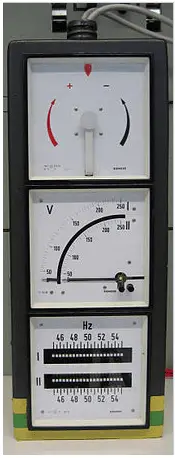Synchronization of the Generator
Following the low power physics tests, the reactor power is increased by further control rods withdrawal to about 10 – 30% of rated thermal power. The reactor is now at zero electrical loads, and all the thermal energy generated is bypassed by the turbine bypass system (TBS) directly to the main condensers.
At this point, the turbine is accelerated to synchronous speed and connected with the grid. Synchronization is the process of matching the speed and frequency of a generator or other source to a running network. The turbine-generator must have equal line voltage, frequency, phase sequence, phase angle, and waveform to the system to which it is being synchronized. As turbine-generator loading is started (turbine control valves open), the turbine bypass valves will ramp shut at a rate that maintains steam pressure until they are fully closed.
At this point, an additional power increase is usually switched to automatic control. After determining that all systems (NSSS and Turbine-generator) are functioning properly at the initial load, the plant loading is continued to full power at a limited rate. This rate usually does not exceed 5 percent of rated power per minute. After refueling, the power increase can be further limited to minimize fuel cladding strain.
Conditions for Synchronization of Generator

As was written, synchronization is the process of matching the speed and frequency of a generator or other source to a running grid. The turbine-generator must have equal line voltage, frequency, phase sequence, phase angle, and waveform to the system to which it is being synchronized. An improper synchronization can result in electrical and mechanical transients that can damage the generator, transformers, and other power system components.
Typically the main generator operates at speeds about:
- 3000 RPM for 50 Hz systems for 2-pole generator (or 1500 RPM for 4-pole generator),
- 1800 RPM for 60 Hz systems for 4-pole generator (or 3600 RPM for 2-pole generator).
With an output voltage of 24,000 volts (i.e., 24 kV), nominal rating – 1111 MVA, effective power – 1000 MWel, power factor – 0,9, and efficiency – 99%.
Thus, synchronizing requires the following conditions of the incoming generator:
- Correct phase sequence and waveform. This requirement must be verified during the initial installation of the generator or after maintenance. Connecting a generator with the wrong phase sequence will result in a short circuit as the system voltages are opposite to those of the generator terminal voltages.
- The frequency is almost exactly equal to that of the system. The generator is brought up to approximate synchronous speed by supplying more mechanical energy to its shaft – for example, opening the control valves on a steam turbine. Improper matching of frequency results in high acceleration and deceleration of a turbine.
- Zero phase angle. The phase angle between the incoming generator voltage and the voltage of the bus bar should be zero.
- Machine terminal voltage is approximately equal to the system voltage.
- Phase voltages in phase with those of the system. Machine terminal voltage and phase voltages can be adjusted by exciter and must be controlled each time a generator is to be connected to a grid.
As can be seen, synchronization matches various parameters of one generator to another generator or the bus bar. As a result, all generators connected in the grid rotate identically with identical speed and in the same phase sequence. The process of synchronization is also called as paralleling of alternators.
Synchronizing Lamps – Synchroscope Method
Different methods are being available for the synchronization of generators. All these methods are based on the check of all five conditions discussed above. The common methods used for synchronizing the generators are given below.
Synchronizing Lamps
The synchronizing lamps method usually uses three lamps connected between the generator terminals and the system terminals. Each of which is rated for generator terminal voltage. The lights will flicker at the frequency proportional to the difference between generator frequency and system frequency as the generator speed changes. When the voltage at the generator is opposite to the system voltage, the lamps will be bright. On the other hand, when the voltage at the generator matches the system voltage, the lights will be dark. At the moment when all the conditions of parallel operation are satisfied, the lamps should be more or less dark. If lamps flicker concurrently, indicating that the phase sequence of the generator matches with the grid. On the other hand, if they flicker one after another, it resembles the incorrect phase sequence.
Synchroscope Method
A synchroscope is a device that indicates the degree to which two systems (e.g., generators) are synchronized with each other. A synchroscope is used for indicating the appropriate moment for synchronization. Synchroscopes measure and display the frequency difference and phase angle between two power systems. The synchroscope has a circular dial over which a pointer is hinged capable of rotating in clockwise and anticlockwise directions. The pointer of the synchroscope will indicate the “fast” or “slow” speed of the generator for the system. If the generator is turning at a lower frequency than the grid, the synchroscope pointer rotates continually in the direction (usually counterclockwise). If the generator is turning at a higher frequency than the grid, the synchroscope pointer rotates continually in the opposite direction (usually clockwise). When these two quantities (difference in frequencies and phase angles) are zero (the pointer stops rotating), it is safe to connect the two systems together. After the machine has been synchronized and is part of the system, it can be made to take its share of the active power by appropriate adjustments of its control valves.